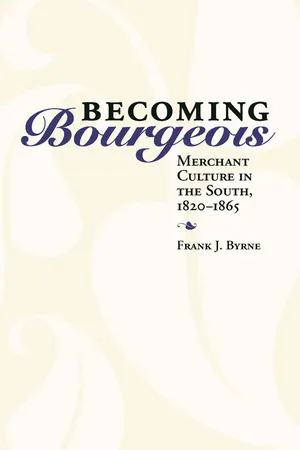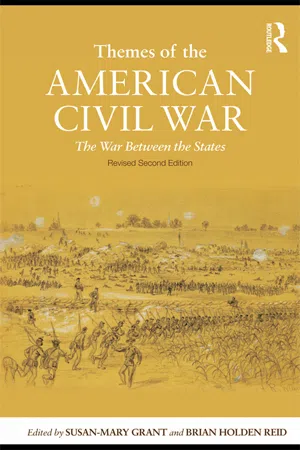History
Secession in the Civil War
Secession in the Civil War refers to the withdrawal of 11 Southern states from the United States in 1860-1861, leading to the formation of the Confederate States of America. This act of secession was driven by the Southern states' desire to protect the institution of slavery and their belief in states' rights. The secession ultimately sparked the American Civil War, a defining conflict in U.S. history.
Written by Perlego with AI-assistance
Related key terms
6 Key excerpts on "Secession in the Civil War"
- eBook - ePub
Eighty-Eight Years
The Long Death of Slavery in the United States, 1777–1865
- Patrick Rael, Richard Newman, Manisha Sinha(Authors)
- 2015(Publication Date)
- University of Georgia Press(Publisher)
SECTION 4 The Civil War and Reconstruction CHAPTER 7 This Terrible War Secession, Civil War, and Emancipation A PREEMPTIVE CONSERVATIVE COUNTERREVOLUTION The Meaning of Secession On November 6, 1860, Americans elected a president for the eighteenth time. When the Kansas-Nebraska Act passed in 1854, the political party he represented had not existed. In the election of 1860, the name Abraham Lincoln did not even appear on the ballot in many southern states. When he nonetheless won, it took but a month for South Carolina, the leading slaveholding state of the Deep South, to secede from the Union and declare its independence—despite that the new president had often averred that slavery was legal in the states where it existed and had promised that under his presidency he would continue to protect it. “I have no purpose, directly or indirectly, to interfere with the institution of slavery in the States where it exists,” he had stated. “I believe I have no lawful right to do so, and I have no inclination to do so.” 1 Ten slaveholding states of the South nonetheless withdrew from the national compact. Their secession led, indirectly though inexorably, to the destruction of the very institution it sought to preserve. Chattel slavery as a legal entity in the United States ended as a consequence of the Civil War. And the war itself began because President Abraham Lincoln refused to accept the dissolution of the Union. The elevation to the presidency of a politician who stood against the expansion of slavery into the western territories thus triggered the formation of the Confederacy - eBook - ePub
Becoming Bourgeois
Merchant Culture in the South, 1820-1865
- Frank J. Byrne(Author)
- 2006(Publication Date)
- The University Press of Kentucky(Publisher)
For the first time in the young country’s history a sectional party, committed to at least the gradual expunging of slavery, had won the presidency. The most serious in a chain of political crises that divided southern and northern sympathies during the 1850s, Lincoln’s election gave defenders of the South’s “peculiar institution” sufficient cause to demand secession. South Carolina, long the most radical southern state, led the secession movement when a special convention took the state out of the Union on December 20, 1860. Six other Deep South states quickly followed suit. Representatives from the secessionist states soon met in Montgomery, Alabama, and formed the Confederate States of America. Of course not all Southerners supported the secession movement. Divisions existed between slaveholders and nonslaveholders, rich and poor, urban and rural, those advocating immediate secession, cooperationists, and those claiming the mere election of a Republican president to be insufficient cause for secession, and finally Unionists who opposed secession on patriotic and constitutional principles. Yet the rivalry of various political and economic factions notwithstanding, a widespread commitment to slavery, white supremacy, and mutual defense against a seemingly hostile antislavery majority united most white Southerners behind secession. During this tumultuous period even merchants, by now mainly ex-Whigs and often political moderates, could agree with the southern nationalist James D. B - eBook - ePub
History Teaches Us to Hope
Reflections on the Civil War and Southern History
- Charles P. Roland(Author)
- 2010(Publication Date)
- The University Press of Kentucky(Publisher)
Affirmative answers have been given to all of the above arguments. Some evidence can be found for all of them. Possibly all are partially correct. This complexity of ideas reinforces my concern over the prospect of an official, “school-solution” mini-lecture on the subject. To give a further idea of its complexities and nuances, I should like to quote briefly from the writings or lectures of four eminent Civil War scholars.The first of these is Professor William E. Gienapp of Harvard University, who has probed deeply into the political factors leading to the war. He is fully aware of the role of slavery in precipitating secession and, indirectly, the war itself. He says it is impossible to imagine the coming of the Civil War without slavery. I agree. But Gienapp is talking about slavery in the context of the American political structure and ideology.Writing in 1996, Gienapp says that, in this context, the Civil War was a product of the democratic political system itself, and the southern secessionists probably had the better constitutional argument in the fierce debate that led to war. He concludes by saying, “Both sides went to war to save democracy as they understood it. For southern secessionists, at stake was the right of self-government and the fundamental rights of southern whites to control their own destiny. For the North, the war was a struggle to uphold the democratic principles of law and order and majority rule. . . . Well before the fighting started, the sectional conflict represented a struggle for control of the nation’s future.”Let me turn to another highly acclaimed Civil War scholar, Professor James M. McPherson of Princeton University. Perhaps many students of the war would say that he is the preeminent expert on the subject. Certainly, no one has ever accused him of holding a pro-Confederate bias. In an essay produced in 1983, he wrote that the South’s pre–Civil War vision of America departed less from the revolutionary model than did that of the North. “Thus when secessionists protested in 1861 that they were acting to preserve traditional rights and values, they were correct. They fought to protect their constitutional liberties against the perceived northern threat to overthrow them. The South’s concept of republicanism had not changed in three-quarters of a century. The North’s had. With complete sincerity the South fought to preserve its version of the republic of the founding fathers—a government of limited powers that protected the rights of property and whose constituency comprised an independent gentry and yeomanry of the white race undisturbed by large cities, heartless factories, restless free workers, and class conflict.” - eBook - ePub
- Lord Charnwood(Author)
- 2012(Publication Date)
- Dover Publications(Publisher)
CHAPTER VISECESSION
1. The Case of the South against the Union .THE Republicans of the North had given their votes upon a very clear issue, but probably few of them had fully realised how grave a result would follow. Within a few days of the election of Lincoln the first step in the movement of Secession had been taken, and before the new President entered upon his duties it was plain that either the dissatisfied States must be allowed to leave the Union or the Union must be maintained by war.Englishmen at that time and since have found a difficulty in grasping the precise cause of the war that followed. Of those who were inclined to sympathise with the North, some regarded the war as being simply about slavery, and, while unhesitatingly opposed to slavery, wondered whether it was right to make war upon it; others, regarding it as a war for the Union and not against slavery at all, wondered whether it was right to make war for a Union that could not be peaceably maintained. Now it is seldom possible to state the cause of a war quite candidly in a single sentence, because as a rule there are on each side people who concur in the final rupture for somewhat different reasons. But, in this case, forecasting a conclusion which must be examined in some detail, we can state the cause of war in a very few sentences. If we ask first what the South fought for, the answer is: the leaders of the South and the great mass of the Southern people had a single supreme and all-embracing object in view, namely, to ensure the permanence and, if need be, the extension of the slave system; they carried with them, however, a certain number of Southerners who were opposed or at least averse to slavery, but who thought that the right of their States to leave the Union or remain in it as they chose must be maintained. If we ask what the North fought for, the answer is: A majority, by no means overwhelming, of the Northern people refused to purchase the adhesion of the South by conniving at any further extension of slavery, and an overwhelming majority refused to let the South dissolve the Union for slavery or for any other cause. - eBook - ePub
Themes of the American Civil War
The War Between the States
- Susan-Mary Grant, Brian Holden-Reid(Authors)
- 2009(Publication Date)
- Routledge(Publisher)
PART IIAnd the War Came …Passage contains an image
CHAPTER 2Southern Secession in 1860–1861
BRUCE COLLINS
The main dilemma for scholars of the coming of the Civil War, and more precisely of its main precipitating event, the coming of secession in the South during the winter of 1860–61, resides in the multiplicity of interpretations on offer. It is sometimes easier to say where interpretations are wrong than where a particular interpretation is wholly right. The historian is classically engaged in the perennial dilemma of trying to reconcile long-term historical developments with precise political decisions. Some of the most recent general interpretations of the period continue to highlight this fundamental dilemma. In a monumental two-volume work, the second volume of which has just appeared, John Ashworth provides an excellent example of the highly structured workings of long-term economic and social factors in his analysis of the coming of confrontation between the two sections.1 On the other side James McPherson in his trenchant and highly successful reassessment of the mid-nineteenth century and the Civil War in particular argues repeatedly for the importance of contingency.2 In this chapter I would like to examine a particular theme central to an understanding of secession and consider how recent working have illuminated and clouded it.Nearly 100 years ago the white Southern historian Ulrich B. Phillips wrote of Georgia’s experience of secession, “It is not easy to determine whether the policy of secession was radical or conservative. Its advocates as well as its opponents claim the quality of conservatism for their respective causes, and each party had some ground to their contention.”3 - eBook - ePub
Mississippi
A History
- Westley F. Busbee(Author)
- 2014(Publication Date)
- Wiley-Blackwell(Publisher)
Chapter 11 Secession and Civil WarAn African American once told General Robert E. Lee, “I’m a soldier. … I belong to your army.” Lee asked, “Well, have you been shot?” He replied, “No, sir; I ain’t been shot yet.” Lee asked, “How is that? Nearly all of our men get shot.” The black man replied, “Why, General, I ain’t been shot ’cause I stay back whar de generals stay.”1Chapter Objectives
- Explain how Mississippians voted in the 1860 presidential election and why the election’s results led to the state’s secession from the Union. In addition, explain the process used to secede.
- List and briefly explain the key military events and identify the wartime leaders in Mississippi during the Civil War.
- Describe the various social, economic, and political difficulties that Mississippians experienced within the state during the war.
John Jones Pettus, November 1859–November 1863
The state Democratic Convention of 1859 adopted a resolution favoring immediate secession should a Republican party candidate win the presidential election of 1860. Meanwhile, the Democratic candidate for governor, John J. Pettus, described as “a grim, abrupt,” stubborn, tobacco-chewing man, made secession the main issue in the campaign and won the office by a wide margin. Indeed, 77 percent of the voters favored Pettus and his pro-secession position, and two years later (in 1861) after the state had withdrawn from the United States, joined the Confederate States, and entered the war, Pettus won reelection without significant opposition.At the beginning of the Civil War, Mississippi’s total population stood at 791,305, including 353,899 whites and 437,404 black slaves and other persons of color. Even though for the first time in the state’s history the rate of population growth had slowed during the 1850s—a decade of increasing sectional strife—the total number of inhabitants had still increased by more than 30 percent. The enslaved black population had experienced a greater rate of growth than the white population—more than 40 percent for slaves to less than 20 percent for whites.
Learn about this page
Index pages curate the most relevant extracts from our library of academic textbooks. They’ve been created using an in-house natural language model (NLM), each adding context and meaning to key research topics.





